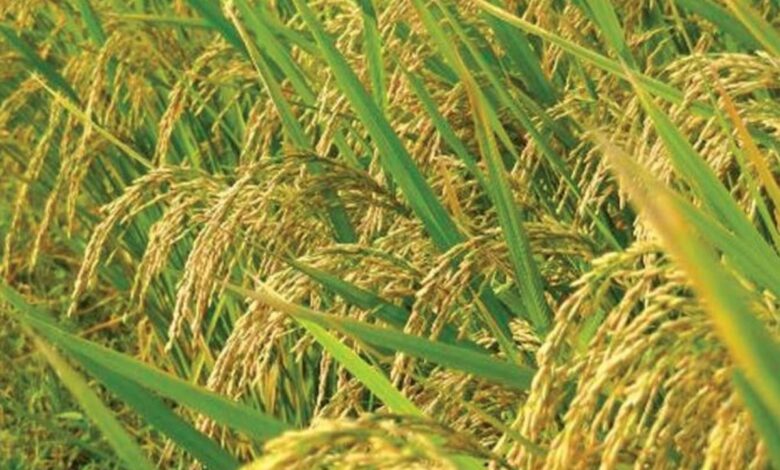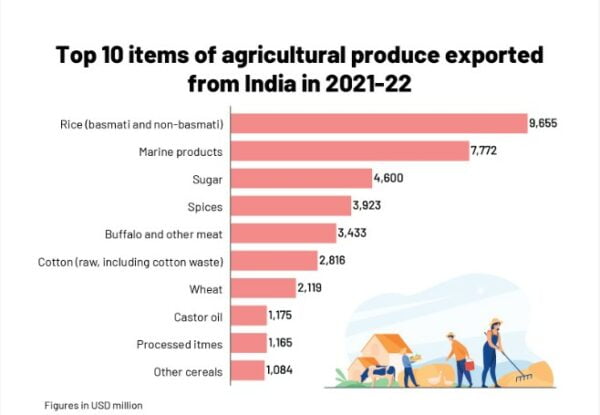How India can reach USD100 billion in agri-exports by 2030 with infrastructure, new markets, and farm clusters

In an article we wrote for a major newspaper two years ago, we suggested many ways to increase the amount and value of agri-exports under the Agri Export Policy (AEP) 2018. The policy’s goal was to double agri-exports to USD60 billion by 2022. India made an extra USD8.4 billion in agri-exports in 2021-22, bringing the total to USD50.2 billion. This is an increase of about 20% over the 2020-21 figure of USD41.8 billion.
In the next step, can India add another $9.8 billion to this number to bring agri-exports to $60 billion by 2022-2023? It’s a challenging goal, but policymakers, farmers, processors, and exporters can reach it. If they are successful, it will show that the country is willing and able to use the export potential of the farm sector and aim for USD100 billion by the end of this decade. To figure out how that can be done, it’s essential to look at the journey so far and the situation in which India has made a lot of progress recently.

A market full of goods
India’s exports of USD50 billion are a small part of its agricultural output and a small part of the USD2 trillion worth of agricultural trade around the world in 2021-22. Agriculture and related industries like forestry and fisheries make up 18.8% of the country’s GDP, which is 2020-21, equal to about $500 billion.
India has the chance to increase its share of global agricultural trade by 5 percent by taking advantage of the diversity of its agricultural sectors. These sectors include foodgrains, horticulture, livestock, dairying, fisheries, and forestry in raw, processed, and value-added forms. Currently, agri-exports make up 14.6% of the domestic production of spices and herbs, 15% of the domestic output of rice, and 25% of the domestic production of sugar. However, organic products and fresh fruits and vegetables make up 0% of the domestic output. India’s farm products that can be exported have a lot of room for improvement in production, processing, and adding value.
What does India sell abroad?
Here’s a quick look at India’s main exports in 2021-22. Other products included tea, tobacco, fresh and processed fruits, edible oil, oilseeds and oil meal, dairy products, alcoholic drinks, and Ayush and herbal products.

Agri-exports data for 2021-22 shows a strong trend in the export of cereals, spices, meat, and cotton, all of which India has always done well with. India is responsible for half of the world’s rice exports, worth about USD9.6 billion. The price of non-basmati rice is USD6.1 billion, and the cost of basmati rice is USD3.5 billion.
The pandemic gave African and Asian countries a great chance to buy rice that wasn’t basmati at a reasonable price. In 2021-22, the amount of rice grown in the U.S. stayed the same, at 127.9 million tonnes. Indian shrimp, fish, and fishery products were exported to Japan, the European Union, China, south-east Asia, and West Asia, where they were in high demand.
Exports of meat, such as buffalo, sheep, and goat, reached USD3.4 billion. India also sent out dairy products worth $634 million. The Pradhan Mantri Matsya Sampada Yojana, which was started in May 2020 by the Ministry of Fisheries, Animal Husbandry, and Dairying, helped exports.
A set of steps to make things better
India’s agri-exports went from US$33 billion in 2016–17 to US$50 billion in 2021–22, thanks in large part to the Agri Export Policy 2018 and targeted domestic production schemes. The following things helped bring about this change:
- An effective policy framework
- Strategies for trade that are made for partners who import
- Port infrastructure and logistics are under pressure
- Creating partnerships along the value chain
- Indian missions abroad work together smoothly.
Several ways to connect India’s farms to forks in countries that buy their food also came into play.
#1: India used its digital and IT infrastructure to talk to officials, let them issue legal certificates online, and keep track of customs clearance and the movement of goods. The digital network helped Indian missions in other countries find new market opportunities, connect agricultural businesses with buyers in other countries, and make sure everything ran smoothly to meet the growing demand worldwide.
#2: Landlocked states were able to get around freight problems by using reefer trains, roads, and marketing help to help move freight.
#3: By developing direct links between exports and markets and fostering export-oriented production, clustering has opened up chances for small enterprises and food processors. The promotion of 46 distinct product-district clusters for export has been announced. Varanasi produces fresh fruits and vegetables, whereas Nagpur produces oranges, Anantapur, Kolhapur, and Jalgaon grow bananas, Sangli, Nashik, and Pune have grapes, and Solapur produces pomegranates.
#4: Efforts were made to increase India’s agri-exports and encourage the export of products that are only made in India.
#5. Key export items’ dedicated traceability systems, like HortiNet, BasmatiNet, and GrapeNet, were made more robust to improve the quality of exports and make India known as a reliable supplier. These systems also helped make the system more open and accountable.
#6. For the first time, the country used a federal institutional mechanism to help promote agricultural exports by getting the states to make their agri-export policies and action plans.
Getting agri-exports going
India has always been known for a few agricultural products, like basmati rice, the world’s first aromatic rice to be labeled with its location. It recently started selling non-basmati rice to buyers in Africa and Asia. In 2021 and 2022, India controlled more than half of the world’s rice trade, and non-basmati rice was the most popular type. India will work harder to get back to the top spot in the market for basmati rice, which has been less in demand in India in recent years.
In the same way, India needs to support its meat-based solid industry. Marine products have recently become one of the most significant opportunities, and if quality-control measures are put in place, this market segment can be made stronger. There is also room to improve infrastructure so that more marine products with added value can be exported.
Adding major spices like chilli, cumin, black pepper, and coriander to the list of notified herbs and cardamom can help boost exports, which have been slowing down in the last two years.
India needs to come up with a way to standardize and open up the market for spices, herbs, medicinal and aromatic plants, and its growing basket of 120 GI food products.
Together with the states, the central government should prioritize growing the clusters of organic products, fresh fruits, and vegetables. It should be possible to get the money needed to set up processing, grading, and packaging units, and it should be possible to use specialized agri-export zones to get benefits.
Since 2019 is the International Year of Millets, India needs to take advantage of its wide range of nutritious cereals and their potential to be used to make products with more value.
There are new plans and new starts.
Agri-businesses can send more fruits and vegetables to the US, like mangoes, pomegranates, and arils. They can also send bananas, sweet corn, and baby corn to Canada, processed foods to the UK, seafood and meat products to China, Japan, the US, and wheat to Egypt and other countries.
Also, Indian missions abroad are working on market intelligence and trade surveillance, continuing to work together on quality food production, and ensuring that importing countries’ food safety standards are met. These are some things that are being done right now to help India reach the USD60 billion goal set in the AEP 2018 by 2022–23.
Incorporating the effects of the pandemic into regular trade practices requires a systemic and targeted policy approach, the launch of a comprehensive Agriculture Export Policy, time-bound approval mechanisms, robust infrastructure, and the strategic engagement of India’s diplomats at the World Trade Organization to defend the country’s support for smallholder farmers and consumers.
India is on its way to becoming a USD100 billion player in international agricultural and food trade, and the recent rise in agri-exports is just the beginning.
edited and proofread by nikita sharma




